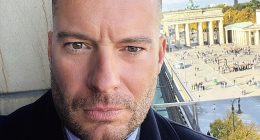Allan Haozous Religion embodies an inspiring blend of tenacity and creativity, forging a path illuminated by his unwavering passion for innovation.
Oklahoma-born Allan Capron Houser, also known as Haozous, was a Chiricahua Apache sculptor, painter, and book artist who lived from June 30, 1914, until August 22, 1915.
He was one of the 20th century’s most well-known Native American artists and Modernist sculptors.
Houser debuted as a professional artist in 1939, participating in the Golden Gate International Exposition and the 1939 New York World’s Fair.
In Washington, DC, he was given his first significant public contract to paint murals at the Main Interior Building. He also wed Santa Fe native Anna Maria Gallegos, who served as his 55-year wife.
Allan Haozous Religion: Was He Christian Or Jewish?
Allan Haozous hasn’t given much information about his faith. But there is one area of his private life that is noticeably missing from the public eye: his religious background.
It is not known for certain whether Allan Haozous is a follower of Christianity, Judaism, or any other religion.
Respecting his right to privacy in this regard is crucial, even though fans and followers might be interested in learning more about this aspect of his life.
Not every well-known person chooses to make their religious connections or beliefs public.
On June 30, 1914, Allan Haozous was born, and he died on August 22, 1994. He was born in Oklahoma and went on to become a Chiricahua Apache sculptor, painter, and book illustrator.
The US Department of Interior gave him another project to create life-sized interior murals in 1940.
Afterwards, Houser went back to Fort Sill to study under Swedish muralist Olle Nordmark, who inspired him to take up sculpture. That year, he carved his first wood pieces.
Read Related Also: Was Kyle Dilegame West Islip Death Linked To Fire: What Happened To Her? Obituary
Allan Haozous Origin And Ethnicity Details
Allan Houser (formerly Hauzous), of Chiracahua Apache and English lineage, was raised in a farming and ranching environment and was well-versed in the Apache heritage of his people, which he learned from his father through songs and stories.
He gained national notoriety for his paintings, which reflected his Native American heritage.
Houser’s career as a WPA muralist began in 1939 when he completed paintings for the Department of the Interior in Washington, D.C.; the Golden Gate Exposition in San Francisco; and the New York World’s Fair.
Soon after, he started creating sculptures at the advice of Olle Nordmark, his muralist tutor. The Haskell Institute in Lawrence, Kansas, gave him his first commission for a piece of public sculpture in 1948.
Houser taught at several colleges in the Southwest from the early 1950s until his retirement from academia in 1975. The Heard Museum in Phoenix, Arizona hosted his first solo exhibition.
His art has evolved over time from wood to stone, from a naturalistic style to more straightforward, colossal forms, all the while preserving figural representations of Native American values.
Allan Haozous Family Details
On June 30, 1914, Allan Houser was born Allan Capron Haozous, which in Apache means “the sound, the sensation of pulling a plant from the earth, and the point at which the earth gives way.”
Born to Sam and Blossom Haozous on the family farm near Apache, Oklahoma, and Fort Sill, Allan became the first member of his family from the Warm Springs Chiricahua Apache tribe to be born outside of captivity since the tribe’s spiritual leader Geronimo’s 1886 surrender and the tribe’s detention by the U.S.
government. Geronimo had led the tribe in battle and would later rely on his grandnephew Sam Haozous, Allan’s father, to act as his translator.
Twenty-year-old Haozous travelled from Oklahoma to Santa Fe, New Mexico, in 1934 to study in Dorothy Dunn’s Art Studio at the Santa Fe Indian School.
Working from personal recollection, eschewing modelling or perspective techniques, and stylizing Native iconography were all encouraged by Dunn’s manner.




